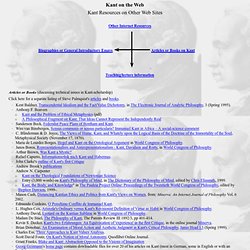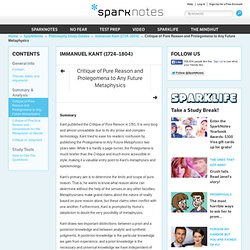

Immanuel Kant: The Critique of Pure Reason. Tips on the Use of Secondary Sources in Philosophy. How to find high-quality secondary sources: There are five main ways to find secondary sources on Kant's Critique of Pure Reason. (1) Search in the Philosopher's Index.

The Philosopher's Index is a more-or-less exhaustive index of all major scholarly publications in philosophy. You can search for articles on Kant there, though you will want to get much more specific than "Kant," which will bring you 10,987 hits. Susan Stuart’s 2008-09 Kant podcast. Metaphor, metonymy, and ... Www.dianahsieh.com/docs/kot.pdf. Philosophy of Math Lecture 28- Kant's Theory of Space and Time - Part 2 of 3. Kant. Collections Online : Kant on the perception of space (and time)
Collections Online : Book Home. Kant's Synthetic A Priori Judgments. Due to a disk crash and backup failure, this site has been restored from an old backup with a number of more recent articles missing.

The missing site content is being restored as time permits. We apologise for any inconvenience. A Constrained Rant by The Famous Brett Watson, 16-May-2003. In his Inaugural Dissertation (On the Form and Principles of the Sensible and Intelligible World), Immanuel Kant claimed (for the last time, it seems) that our reason allows us to represent things as they are, as opposed to things as they appear. The model of cognition which he felt allowed him to make such a claim involved the distinct segregation of "sensible" objects and "intelligible" objects, with the distinct powers of "sensibility" and "intellect" having respective jurisdiction over them. If it is not the world of experience that provides the intellect with the objects of which its ideas are true, what reason is there for thinking that there are any such objects? A priori empirical analytic , and. Kant's Transcendental Dialectics.
Transcendental dialectics ‘Transcendental dialectic is not the art of producing dogmatically illusion, but a critique of understanding and reason in regard to their hyperphysical use’.

(p70CPR) ‘All our knowledge begins with sense, proceeds thence to understanding, and ends with reason.’ (CPR, p.211) Briefly, dialectics for Plato represented the highest degree of knowledge, for Aristotle it was a probabilistic syllogism, whereas for Kant it is the analysis of the obstacles to reason. There can be empirical illusory appearances (such as optical ones), but here Kant is concerned with transcendental illusory appearances, arising when ’the subjective necessity of a certain connection of our conceptions, is regarded as an objective necessity of the determination of things themselves.’ These illusions are impossible to avoid. Www.filosofia.cchla.ufrn.br/juan/worksinprogress/allison_guyer_kant.pdf. Kant's Prolegomena. Our web site has recently gone through a redesign and the page you are looking for might have been removed, had its name changed, or is temporarily unavailable.

Please try the following: Use search to find the new location of the information. Return to the home page and use the navigation to find the information. Attempt to use the web.mnstate.edu address to access the content: 306/kant_materials/prolegomena1.htm If you reached this page by clicking a link, contact the Web site administrator to alert them that the link is incorrectly formatted. Click HERE to return to the MSUM home page. Works by Karl Ameriks. Works by Beatrice Longuenesse. Kant's Critique of Pure Reason: Significant Secondary Sources. Meaning and the Problem of Universals. One of the most durable and intractable issues in the history of philosophy has been the problem of universals.

Closely related to this, and a major subject of debate in 20th century philosophy, has been the problem of the nature of the meaning. The problem of universals goes back to Plato and Aristotle. The matter at issue is that, on the one hand, the objects of experience are individual, particular, and concrete, while, on the other hand, the objects of thought, or most of the kinds of things that we know even about individuals, are general and abstract, i.e. universals. Thus, a house may be red, but there are many other red things, so redness is a general property, a universal. There are also many houses, and even kinds of houses, so the nature of being a house is general and universal also.
Plato's answer to this was that universals exist in a separate reality as special objects, distinct in kind, from the things of experience. Critique of Pure Reason. Critique of Pure Reason The e-text version of this book is based on the 1929 Norman Kemp Smith translation, and appears in eight parts, as follows: I.

Prefaces and Introduction (pp.4-62) II. Aesthetic (pp.63-91) III. Analytic of Concepts (pp.92-175) IV. This e-text version of this book was originally prepared by Stephen Palmquist and placed in the Oxford Text Archive in 1985. Important Copyright Notice. Kant on the Web: Resources on Other Web Sites. Kant on the Web Kant Resources on Other Web Sites Other Internet Resources Biographies or General Introductory Essays Articles or Books on Kant Teaching/lecture information Articles or Books (discussing technical issues in Kant-scholarship) Click here for a separate listing of Steve Palmquist's articles and books.

Immanuel Kant (1724–1804): Critique of Pure Reason and Prolegomena to Any Future Metaphysics. Summary Kant published the Critique of Pure Reason in 1781.

It is very long and almost unreadable due to its dry prose and complex terminology. Kant tried to ease his readers’ confusion by publishing the Prolegomena to Any Future Metaphysics two years later. While it is hardly a page-turner, the Prolegomena is much briefer than the Critique and much more accessible in style, making it a valuable entry point to Kant’s metaphysics and epistemology.